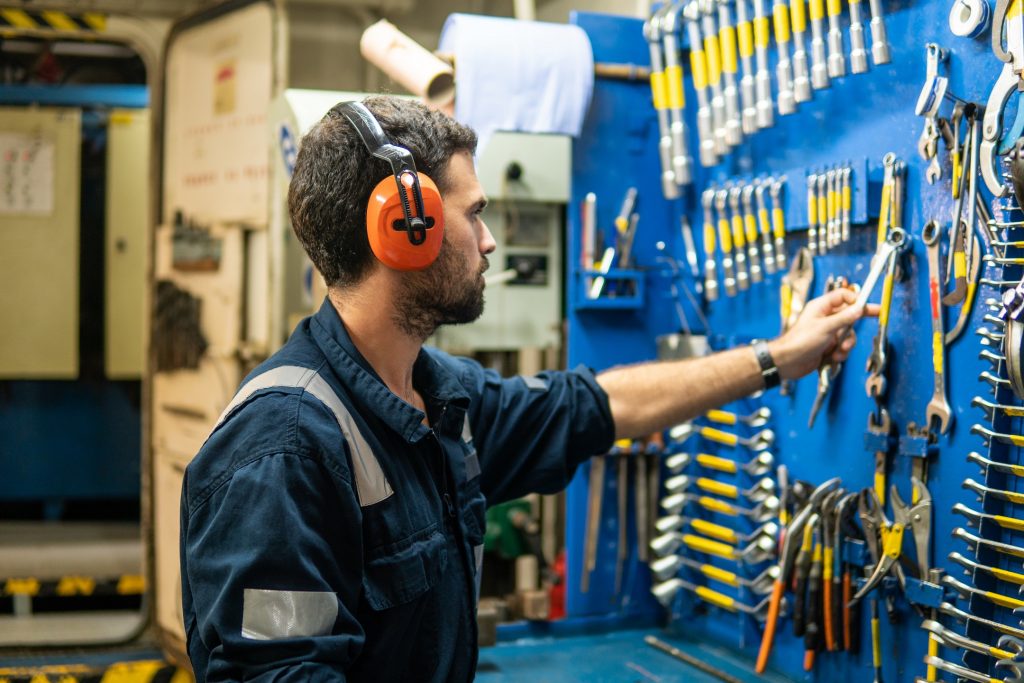A Marine Engineer Officer or Maritime Engineer Officer is a licensed seafarer qualified and responsible for safely operating and maintaining the technical systems and machinery of the ship. Engineering officers are usually educated and trained as engineering technicians. Ship engineers are responsible for but not limited to ship main propulsion, auxiliary machinery, piping, automation and control systems. They require a certain level of knowledge from different sciences of mechanical engineering, electrical engineering, electronics, pneumatics, hydraulics, chemistry, steam generation, and gas turbines.
A marine engineer officer must meet minimum requirements regarding standards of competence, seagoing service time, medical fitness and age. He or she should have a valid certificate of competence according to his /her rank and functions on board. The STCW Code chapter III (engine department) should be consulted to know each certificate’s exact requirements and competencies. The issuing administration should endorse this certificate. The marine engineer officer should also have all the ancillary certificates required for those referring to safety duties on board-specific types of ships ( such as LNG carriers).
A marine engineer plays a pivotal role in ensuring crew safety as he deals with safe operation, maintenance, and breakdown of ship machinery. The expertise and competencies of marine (maritime) engineers are sometimes accepted as suitable for working as an engineer for military ships, port technical departments, submarines, or off-shore platforms. Different technical systems contribute to any vessel’s operations, like the propulsion, electrical power system, lubrication systems, fuel systems, water distillation, lighting, deck cranes, refrigeration system, and air conditioning system etc. These are all included in the technical responsibilities of a marine engineer. A marine engineer may work on different types of vessels, depending upon his/her background training and expertise, which can be categorised as container ships, tanker ships, bulk carrier vessels, passenger ships, coastal vessels, ferry vessels, dynamic position vessels, off-shore platforms and ships, and port assisting boats and ships (tugs, barges etc.).
Precise competencies and qualifications for a marine engineer officer are set by International Maritime Organization (IMO). In 1978, under STCW Convention, IMO established basic requirements by the IMO on training, certification and watchkeeping for seafarers on an international level. Previously the standards of training, certification and watchkeeping of officers and ratings were established by individual governments, and as a result, these standards and procedures varied widely. The primary purpose of the convention is to promote the safety of life and property at sea and the protection of the marine environment by establishing in common agreement international standards of training, certification and watchkeeping for seafarers. Revisions to the conventions occurred in 1984, 1995, 1997, and 2010 of which major revisions were in 1995 and 2010.
The STCW Code contains mandatory provisions to which specific references are made in the STCW Convention’s annexe. These provisions detail the minimum standards required by Parties to give full effect to the convention. Also contained in this part are standards of competence required to be demonstrated by candidates for the issue and revalidation of competency certificates under the STCW Convention provisions.
Under STCW, the Engineer Officers of the Watch (EOOW) is the officer on watch and in charge of the ship’s main propulsion plant and the associated auxiliaries. They are responsible for the safe and proper operation of such units and for performing the duties prescribed in these regulations and by other competent authorities.
Under STCW, the Engineer Officers of the Watch is the officer on watch and in charge of the ship’s main propulsion plant and the associated auxiliaries. They are responsible for the safe and proper operation of such units and for performing the duties prescribed in these regulations and by other competent authorities.
Ship Engineering department and watchkeeping
An engine or engineering department is an organisational unit aboard a ship responsible for operating, maintaining, and repairing the propulsion systems and support systems for the crew, passengers, and cargo. To be an Engineer Officer Of the Watch (EOOW) and have the license for it, there are three basic requirements: Age, Seagoing service, and Education/training according to STCW that results in evidence of the standard of competence, called Certificate of Competency (CoC). Currently, due to the increase in automation on commercial vessels and the increase in unattended machinery spaces (UMS), the number of engine officers has dramatically decreased on board merchant ships to cut the costs for ship owners/operators.
Today, the engine department usually consists of the following number of engine officers and ratings for a typical cargo ship:
- (1) Chief engineer
- (1) Second engineer (sometimes this rank is named First Engineer)
- (1-2) Third engineer
- (1-2) Fourth engineer
- Engine Cadet
- (0-2) Motorman/Fitter/technician
- (0-2) Oiler
- (0-2) Wiper/Greaser

Many vessels also carry a specific type of engine officer known as an Electro-Technical Officer (ETO). Depending on the type of the ships, multiple ETOs may look after the electrical and electronic systems and apparatus. Typically, a ship’s engine department is run by the engine officers in charge, with the bits of help from engine ratings:
- Machinist/Fitter/technician: A rating who is specialised and experienced in fabrication, welding, etc.
- Motorman: qualified engine rating who stands a watch with the engine officer, performs routine tasks, and assists engine officers during maintenance.
- Oiler: A rating responsible for ensuring that machinery is adequately lubricated, other tasks such as cleaning, sounding tanks etc.
- Wiper: Usually, the lowest rating in the engine room and is tasked with keeping the machinery spaces clean and tidy.
Marine Engineer Officers’ income
A candidate becomes eligible to work on ships after 3-4 years of a marine engineering degree course (after pursuing required supplementary courses). A fresh marine engineering graduate will join a ship as a junior engineer, usually for six months as a 4th or 3rd marine engineer. Beginning marine engineers usually work under the supervision of experienced engineers. Gaining a good amount of experience and based on performance, a company will provide a promotion. After completing the required sea time as a third engineer, one can give Class II exams to become a second engineer. Similarly, after finishing the necessary sea time and gaining a good amount of experience, a second engineer can take the Class I exam to get promoted to chief engineer. Note that the promotion is a process that might differ in the country and company one belongs to.
The salary of a marine engineer mainly depends on the ship he/she is working on, the shipping company, and the experience level. It may vary based on one’s nationality, and the country one belongs to. A rough example of the payments for marine engineers involved in international voyages on a cargo ship is listed below ( in USD$/month); it is a roughly estimated range and varies according to the earlier factors.
Fourth engineer – $2000-3000
Third engineer – $3000-5000
Second engineer – $4500 – $9000
Chief engineer -$7000 – $13000

How to Become a Marine Engineer?
Marine engineering is a job that has gained attraction in the last decades. The growth of international shipping activities across the seas also positively impacted marine engineering with an unprecedented rise in global trading. All this has positively impacted the job market in this dynamic sector. Certain attributes are pre-requisites for a marine engineer. Some colleges and institutes offer both degree and post-graduate marine engineering courses. It is supposed to be the first base for someone with ambitions of becoming a marine engineer. The eligibility required to take admission in these courses is the same worldwide: senior secondary certificate.
The length of the engineering graduate course may vary slightly in some countries; generally, it is 3.5-4 years, wherein the student undergoes comprehensive training in both theoretical and practical aspects of the science. The theoretical subjects include, apart from English, computer science, applied mathematics, physics, electronics and marine management. Besides these, many other topics are covered, and students are educated regarding environmental science, maritime commerce and control systems, etc. This training is necessary for anyone aspiring to be a marine engineer or wanting a merchant navy job because it adds to the mental abilities and inculcates physical attributes.
Future opportunities after studying Marine Engineering
Marine engineers find jobs in Shipping firms, Navy, Shipyards, Engine manufacturing companies, Shipbuilding firms, Ship design firms, Maritime universities, Ship classification societies, Research Institutions, etc.
A Master of Science (MSc) degree in any maritime or marine discipline can pave the way for the shore job markets related to the maritime industry. These MSc programmes emphasize the practical applications of expertise. They offer an overview of the complex, inter-related maritime and ocean fields and the opportunity to specialize. These programmes are usually designed to respond directly to the maritime industry’s real needs and equip graduates with the skills needed today and in the future. It is academically challenging, professionally oriented, and designed for ambitious, mid-career maritime professionals. It provides a particularly strong foundation for those intending to move into either a national or an international career. In any case, the most successful in this field were those who had a clear idea of what they wanted out of this industry and which of their characteristics suited it the best.
With the recent studies predicting steady growth in the global economy and trade, this industry is more or less set to keep progressing. This is because ‘shipping’ is still the easiest, cheapest, and most environmental-friendly mode of transport worldwide. Therefore the profile of a marine (maritime) engineer would remain a centre of attraction for the youths for years.
Source: MaritimEducation.com


Your point of view caught my eye and was very interesting. Thanks. I have a question for you.
Thanks for sharing. I read many of your blog posts, cool, your blog is very good.
Great article! I appreciate the clear and insightful perspective you’ve shared. It’s fascinating to see how this topic is developing. For those interested in diving deeper, I found an excellent resource that expands on these ideas: check it out here. Looking forward to hearing others’ thoughts and continuing the discussion!
I don’t think the title of your article matches the content lol. Just kidding, mainly because I had some doubts after reading the article.
Thank you very much for sharing, I learned a lot from your article. Very cool. Thanks.
Your article helped me a lot, is there any more related content? Thanks!